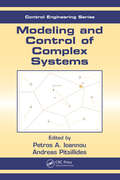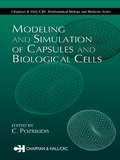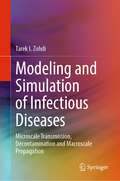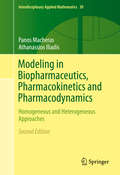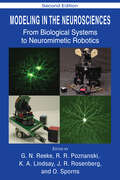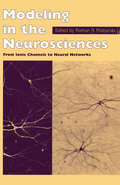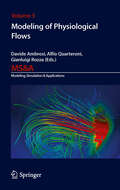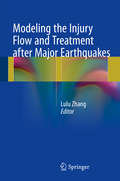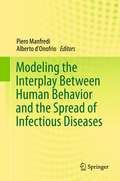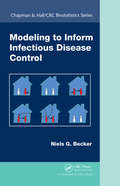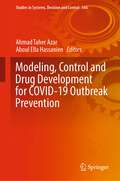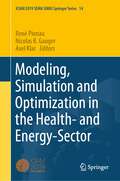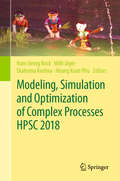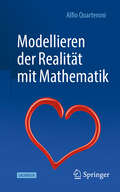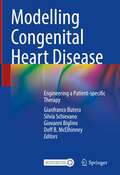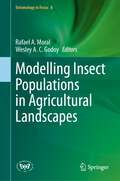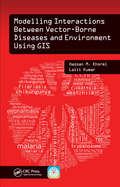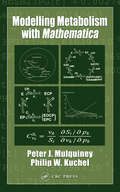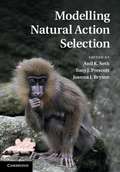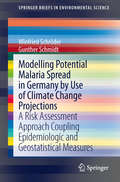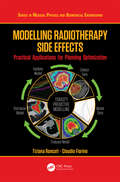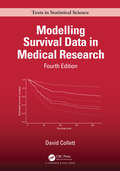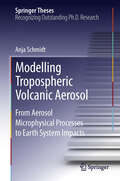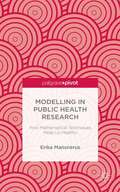- Table View
- List View
Modeling and Control of Complex Systems (ISSN #26)
by Andreas Pitsillides Petros A. IoannouThere is an emerging interest in the area of modeling and control of complex systems for applications in many engineering and non-engineering fields such as biology, transportation, robotics, information technology, and communications. This text provides a pioneering, single-source compilation of material from internationally renowned experts with different approaches to the applications of modeling and control of complex systems. Sections cover complex systems, biological systems, communication networks, sensor networks and automation, autonomous vehicles and robotics, transportation systems and structures, and others. The authors highlight the most important areas of research, the latest advances, and possible future directions.
Modeling and Simulation of Capsules and Biological Cells (Chapman And Hall/crc Mathematical Biology Ser.)
by C. PozrikidisIn the past three decades, considerable progress has been made in the mathematical analysis, modelling, and simulation of the fluid dynamics of liquid capsules and biological cells, and interest in this area is now at an all-time high. This book features a collection of chapters contributed by acknowledged leaders in the field who explore topics re
Modeling and Simulation of Infectious Diseases: Microscale Transmission, Decontamination and Macroscale Propagation
by Tarek I. ZohdiThe COVID-19 pandemic that started in 2019-2020 has led to a gigantic increase in modeling and simulation of infectious diseases. There are numerous topics associated with this epoch-changing event, such as (a) disease propagation, (b) transmission, (c) decontamination, and (d) vaccines. This is an evolving field. The targeted objective of this book is to expose researchers to key topics in this area, in a very concise manner. The topics selected for discussion have evolved with the progression of the pandemic. Beyond the introductory chapter on basic mathematics, optimization, and machine learning, the book covers four themes in modeling and simulation infectious diseases, specifically: Part 1: Macroscale disease propagation, Part 2: Microscale disease transmission and ventilation system design, Part 3: Ultraviolet viral decontamination, and Part 4: Vaccine design and immune response. It is important to emphasize that the rapid speed at which the simulations operate makes the presented computational tools easily deployable as digital twins, i.e., digital replicas of complex systems that can be inexpensively and safely optimized in a virtual setting and then used in the physical world afterward, thus reducing the costs of experiments and also accelerating development of new technologies.
Modeling in Biopharmaceutics, Pharmacokinetics and Pharmacodynamics
by Panos Macheras Athanassios IliadisThe state of the art in Biopharmaceutics, Pharmacokinetics, and Pharmacodynamics Modeling is presented in this new second edition book. It shows how advanced physical and mathematical methods can expand classical models in order to cover heterogeneous drug-biological processes and therapeutic effects in the body. The book is divided into four parts; the first deals with the fundamental principles of fractals, diffusion and nonlinear dynamics; the second with drug dissolution, release, and absorption; the third with epirical, compartmental, and stochastic pharmacokinetic models, with two new chapters, one on fractional pharmacokinetics and one on bioequivalence; and the fourth mainly with classical and nonclassical aspects of pharmacodynamics. The classical models that have relevance and application to these sciences are also considered throughout. This second edition has new information on reaction limited models of dissolution, non binary biopharmaceutic classification system, time varying models, and interface models. Many examples are used to illustrate the intrinsic complexity of drug administration related phenomena in the human, justifying the use of advanced modeling methods. This book will appeal to graduate students and researchers in pharmacology, pharmaceutical sciences, bioengineering, and physiology. Reviews of the first edition: "This book presents a novel modelling approach to biopharmaceutics, pharmacokinetics and pharmacodynamic phenomena. This state-of-the-art volume will be helpful to students and researchers in pharmacology, bioengineering, and physiology. This book is a must for pharmaceutical researchers to keep up with recent developments in this field. " (P. R. Parthasarathy, Zentralblatt MATH, Vol. 1103 (5), 2007) "These authors are the unique (or sole) contributors in this area that are working on these questions and bring a special expertise to the field that is now being recognized as essential to understanding biological system and kinetic/dynamic characteristics in drug development. . . This text is an essential primer for those who would envision the incorporation of heterogeneous approaches to systems where homogeneous approaches are not sufficient to describe the system. " (Robert R. Bies, Journal of Clinical Pharmacology, Vol. 46, 2006)
Modeling in the Neurosciences: From Biological Systems to Neuromimetic Robotics
by R. R. Poznanski G. N. Reeke K. A. Lindsay J. R. Rosenberg O. SpornsComputational models of neural networks have proven insufficient to accurately model brain function, mainly as a result of simplifications that ignore the physical reality of neuronal structure in favor of mathematically tractable algorithms and rules. Even the more biologically based "integrate and fire" and "compartmental" styles of modeling suff
Modeling in the Neurosciences: From Ionic Channels to Neural Networks
by Roman R. PoznanskiWith contributions from more than 40 renowned experts, Modeling in the Neurosciences: From Ionic Channels to Neural Networks is essential for those interested in neuronal modeling and quantitative neiroscience. Focusing on new mathematical and computer models, techniques and methods, this monograph represents a cohesive and comprehensive treatment
Modeling of Physiological Flows
by Gianluigi Rozza Alfio Quarteroni Davide AmbrosiThis book offers a mathematical update of the state of the art of the research in the field of mathematical and numerical models of the circulatory system. It is structured into different chapters, written by outstanding experts in the field. Many fundamental issues are considered, such as: the mathematical representation of vascular geometries extracted from medical images, modelling blood rheology and the complex multilayer structure of the vascular tissue, and its possible pathologies, the mechanical and chemical interaction between blood and vascular walls, and the different scales coupling local and systemic dynamics. All of these topics introduce challenging mathematical and numerical problems, demanding for advanced analysis and efficient simulation techniques, and pay constant attention to applications of relevant clinical interest. This book is addressed to graduate students and researchers in the field of bioengineering, applied mathematics and medicine, wishing to engage themselves in the fascinating task of modeling the cardiovascular system or, more broadly, physiological flows.
Modeling the Electrochemo-poromechanics of Ionic Polymer Metal Composites and Cell Clusters (Springer Theses)
by Alessandro LeronniThis book presents a novel continuum finite deformation framework addressing the complex interactions among electrostatics, species transport, and mechanics in solid networks immersed in a fluid phase of solvent and ions. Grounded on cutting-edge multiphysics theories for soft active materials, the proposed model is primarily applied to ionic polymer metal composites (IPMCs). First, the influence of shear deformation on the IPMC response is analyzed through semi-analytical solutions obtained via the method of matched asymptotic expansions. Second, the novel electrochemo-poromechanical theory is used to predict the curvature relaxation and electric discharge that are observed in IPMC actuation and sensing, respectively, under a sustained stimulus. This newly formulated theory is, in turn, applied to biological cell clusters. Here, important mechanical considerations are integrated into classical bioelectrical models, thus offering novel insights into the interplay of mechanical and electrical signaling in the coordination of developmental processes.
Modeling the Injury Flow and Treatment after Major Earthquakes
by Lulu ZhangThis book discuss a series of earthquake emergency medical rescue complex models, which can provide theoretical support for medical disaster rescue work in the future. This book consists of three parts. The first part is an introduction (chapter 1) which makes an overview of the purpose, meaning, methods and relative theory using in the research. The second part (chapter 2 to 8) includes "casualty flow" related factors such as the occurrences of earthquake casualty, the Length of Stay among the Hospitalized Patients, the medical evacuation in earthquake and rescue force related factors such as the medical rescue forces allocation in earthquake, the organization and command of earthquake rescue forces, Location and Distribution of Medical Rescue Institutions and from peacetime to wartime in hospital. The third part (chapter 9) is a summary including conclusion and policy-making suggestion.
Modeling the Interplay Between Human Behavior and the Spread of Infectious Diseases
by Alberto D'Onofrio Piero ManfrediThis volume summarizes the state-of-the-art in the fast growing research area of modeling the influence of information-driven human behavior on the spread and control of infectious diseases. In particular, it features the two main and inter-related "core" topics: behavioral changes in response to global threats, for example, pandemic influenza, and the pseudo-rational opposition to vaccines. In order to make realistic predictions, modelers need to go beyond classical mathematical epidemiology to take these dynamic effects into account. With contributions from experts in this field, the book fills a void in the literature. It goes beyond classical texts, yet preserves the rationale of many of them by sticking to the underlying biology without compromising on scientific rigor. Epidemiologists, theoretical biologists, biophysicists, applied mathematicians, and PhD students will benefit from this book. However, it is also written for Public Health professionals interested in understanding models, and to advanced undergraduate students, since it only requires a working knowledge of mathematical epidemiology.
Modeling to Inform Infectious Disease Control
by Niels G. BeckerEffectively Assess Intervention Options for Controlling Infectious DiseasesOur experiences with the human immunodeficiency virus (HIV), severe acute respiratory syndrome (SARS), and Ebola virus disease (EVD) remind us of the continuing need to be vigilant against the emergence of new infectious diseases. Mathematical modeling is increasingly used i
Modeling, Control and Drug Development for COVID-19 Outbreak Prevention (Studies in Systems, Decision and Control #366)
by Ahmad Taher Azar Aboul Ella HassanienThis book is well-structured book which consists of 31 full chapters. The book chapters' deal with the recent research problems in the areas of modeling, control and drug development, and it presents various techniques of COVID-19 outbreak prevention modeling. The book also concentrates on computational simulations that may help speed up the development of drugs to counter the novel coronavirus responsible for COVID-19.
Modeling, Simulation and Optimization in the Health- and Energy-Sector (SEMA SIMAI Springer Series #14)
by Axel Klar Nicolas R. Gauger René PinnauThis volume is addressed to people who are interested in modern mathematical solutions for real life applications. In particular, mathematical modeling, simulation and optimization is nowadays successfully used in various fields of application, like the energy- or health-sector. Here, mathematics is often the driving force for new innovations and most relevant for the success of many interdisciplinary projects. The presented chapters demonstrate the power of this emerging research field and show how society can benefit from applied mathematics.
Modeling, Simulation and Optimization of Complex Processes HPSC 2018: Proceedings of the 7th International Conference on High Performance Scientific Computing, Hanoi, Vietnam, March 19-23, 2018
by Willi Jäger Hans Georg Bock Hoang Xuan Phu Ekaterina KostinaThis proceedings volume highlights a selection of papers presented at the 7th International Conference on High Performance Scientific Computing, which took place in Hanoi, Vietnam, during March 19-23, 2018. The conference has been organized by the Institute of Mathematics of the Vietnam Academy of Science and Technology, the Interdisciplinary Center for Scientific Computing (IWR) of Heidelberg University and the Vietnam Institute for Advanced Study in Mathematics. The contributions cover a broad, interdisciplinary spectrum of scientific computing and showcase recent advances in theory, methods, and practical applications. Subjects covered include numerical simulation, methods for optimization and control, machine learning, parallel computing and software development, as well as the applications of scientific computing in mechanical engineering, airspace engineering, environmental physics, decision making, hydrogeology, material science and electric circuits.
Modellieren der Realität mit Mathematik
by Alfio QuarteroniDie Simulation des menschlichen Herzens, die Vorhersage des morgigen Wetters, die Optimierung der Aerodynamik eines Segelboots, die Suche nach der idealen Garzeit für einen Hamburger: Bei der Lösung dieser Probleme können Kardiologen, Meteorologen, Sportler und Ingenieure auf mathematische Hilfe zählen. Dieses Buch führt Sie zur Entdeckung einer magischen, aus Gleichungen bestehenden Welt, die für eine Vielzahl von wichtigen Problemen unseres Lebens nützliche Antworten liefern können.Die Übersetzung wurde mit Hilfe von künstlicher Intelligenz durchgeführt. Eine anschließende menschliche Überarbeitung erfolgte vor allem in Bezug auf den Inhalt.
Modelling Congenital Heart Disease: Engineering a Patient-specific Therapy
by Gianfranco Butera Silvia Schievano Giovanni Biglino Doff B. McElhinneyThis book combines medicinal and engineering knowledge to present engineering modelling applications (mainly computational, but also experimental) in the context of facilitating a patient-centred approach to treating congenital heart disease (CHD). After introducing the basic concepts of engineering tools, it discusses modelling and the applications of engineering techniques (e.g. computational fluid dynamics, fluid-structure interaction, structural simulations, virtual surgery, advanced image analysis, 3D printing) in specific congenital heart diseases. It also offers a number of clinical case studies describing the applications in real-life clinical practice. The final section focuses on the importance of surgical training, counselling and patient communication. Considering the unique anatomical arrangement pre/post repair in CHD, as well as the different surgical strategy and device options (e.g. stents) for interventions, a patient-specific approach is certainly warranted in this area of medicine, and engineering is helping improve our understanding of individual patients and their particular anatomy and physiology. To reinforce the idea of a necessary dialogue between clinicians and engineers, this book has not only been edited by two cardiologists and two bioengineers, but each chapter has been written by a clinician and an engineer, incorporating both voices in the description of state-of-the-art models for different CHDs.
Modelling Insect Populations in Agricultural Landscapes (Entomology in Focus #8)
by Rafael A. Moral Wesley A. C. GodoyThis book combines chapters emphasising mathematical, statistical, and computational modelling applied to insect populations, particularly pests or natural enemies in agricultural landscapes. There is a gap between agricultural pest experimentation and ecological theory, which requires a connection to supply models with laboratory, and field estimates and projects receiving inputs and insights from models. In addition, decision-making in entomology with respect to pest management and biological conservation of natural enemies has been supported by results obtained from different computational and mathematical approaches. This book brings contemporary issues related to optimization in spatially structured landscapes, insect movement, stability analysis, game theory, machine learning, computer vision, Bayesian modelling, as well as other frameworks.
Modelling Interactions Between Vector-Borne Diseases and Environment Using GIS
by Hassan M. KhormiMaster GIS Applications on Modelling and Mapping the Risks of DiseasesInfections transmitted by mosquitoes, ticks, triatomine bugs, sandflies, and black flies cause significant rates of death and disease, especially in developing countries. Why are certain places more susceptible to vector-borne diseases? Modelling Interactions Between Vector-Borne
Modelling Metabolism with Mathematica
by Peter Mulquiney Philip W. KuchelWith the advent of sophisticated general programming environments like Mathematica, the task of developing new models of metabolism and visualizing their responses has become accessible to students of biochemistry and the life sciences in general. Modelling Metabolism with Mathematica presents the approaches, methods, tools, and algorithms for mode
Modelling Natural Action Selection
by Tony Prescott Anil Seth Joanna BrysonAction selection is the task of doing the right thing at the right time. It requires the assessment of available alternatives, executing those most appropriate, and resolving conflicts among competing goals and possibilities. Using advanced computational modelling, this book explores cutting-edge research into action selection in nature from a wide range of disciplines, from neuroscience to behavioural ecology, and even political science. It delivers new insights into both detailed and systems-level attributes of natural intelligence and demonstrates advances in methodological practice. Contributions from leading researchers cover issues including whether biological action selection is optimal, neural substrates for action selection in the vertebrate brain, perceptual selection in decision making, and interactions between group and individual action selection. This first integrated review of action selection in nature contains a balance of review and original research material, consolidating current knowledge into a valuable reference for researchers while illustrating potential paths for future studies.
Modelling Potential Malaria Spread in Germany by Use of Climate Change Projections
by Winfried Schröder Gunther SchmidtThis book investigates the spatial distribution of potential temperature-driven malaria transmissions, using the basic reproduction rate (R0) to model the reproduction of the malaria pathogen Plasmodium vivax. The authors mapped areas at risk of an outbreak of tertian malaria in the federal state of Lower Saxony (pre-study) and for whole Germany (main-study) by means of geostatistics for past (1947-2007) and future periods. Projections based on predicted monthly mean air temperature data derived from the IPCC and regionally discriminated by two regional climate models (REMO, WettReg) for the countrywide study.
Modelling Radiotherapy Side Effects: Practical Applications for Planning Optimisation (Series in Medical Physics and Biomedical Engineering)
by Tiziana Rancati Claudio FiorinoThe treatment of a patient with radiation therapy is planned to find the optimal way to treat a tumour while minimizing the dose received by the surrounding normal tissues. In order to better exploit the possibilities of this process, the availability of accurate and quantitative knowledge of the peculiar responses of the different tissues is of paramount importance. This book provides an invaluable tutorial for radiation oncologists, medical physicists, and dosimetrists involved in the planning optimization phase of treatment. It presents a practical, accessible, and comprehensive summary of the field’s current research and knowledge regarding the response of normal tissues to radiation. This is the first comprehensive attempt to do so since the publication of the QUANTEC guidelines in 2010. Features: Addresses the lack of systemization in the field, providing educational materials on predictive models, including methods, tools, and the evaluation of uncertainties Collects the combined effects of features, other than dose, in predicting the risk of toxicity in radiation therapy Edited by two leading experts in the field
Modelling Survival Data in Medical Research (Chapman & Hall/CRC Texts in Statistical Science)
by David CollettModelling Survival Data in Medical Research, Fourth Edition, describes the analysis of survival data, illustrated using a wide range of examples from biomedical research. Written in a non-technical style, it concentrates on how the techniques are used in practice. Starting with standard methods for summarising survival data, Cox regression and parametric modelling, the book covers many more advanced techniques, including interval-censoring, frailty modelling, competing risks, analysis of multiple events, and dependent censoring. This new edition contains chapters on Bayesian survival analysis and use of the R software. Earlier chapters have been extensively revised and expanded to add new material on several topics. These include methods for assessing the predictive ability of a model, joint models for longitudinal and survival data, and modern methods for the analysis of interval-censored survival data. Features: Presents an accessible account of a wide range of statistical methods for analysing survival data Contains practical guidance on modelling survival data from the author’s many years of experience in teaching and consultancy Shows how Bayesian methods can be used to analyse survival data Includes details on how R can be used to carry out all the methods described, with guidance on the interpretation of the resulting output Contains many real data examples and additional data sets that can be used for coursework All data sets used are available in electronic format from the publisher’s website Modelling Survival Data in Medical Research, Fourth Edition, is an invaluable resource for statisticians in the pharmaceutical industry and biomedical research centres, research scientists and clinicians who are analysing their own data, and students following undergraduate or postgraduate courses in survival analysis.
Modelling Tropospheric Volcanic Aerosol
by Anja SchmidtAnja Schmidt's thesis is a unique and comprehensive evaluation of the impacts of tropospheric volcanic aerosol on the atmosphere, climate, air quality and human health. Using a state-of-the-art global microphysics model, the thesis describes and quantifies the impact of volcanic sulphur emissions on global aerosol, clouds and the radiative forcing of climate. The advanced model enables the first ever estimate of the impact of the emissions on aerosol microphysical properties such as particle number concentrations and sizes, and therefore a considerably improved ability to quantify the climate and air quality effects. There are several important discoveries in this thesis. Firstly, it is shown that continuously degassing volcanoes exert a major effect on global clouds and climate. Secondly, the impact of the 1783 Laki eruption in Iceland is re-examined to show that this long-lasting flood lava eruption would have had major effects on clouds and climate. Thirdly, by combining her research on volcanism, atmospheric science and epidemiology, she shows that a present-day Laki-like eruption would seriously affect European air quality and cause over 100000 premature deaths in the first year.
Modelling in Public Health Research: How Mathematical Techniques Keep Us Healthy
by Erika MansnerusThis book analyses the development and use of mathematical models in public health research and policy. By introducing a life cycle metaphor, the author provides a unique perspective on how mathematical modelling techniques have increased our understanding of the governance of infectious risks in society.
